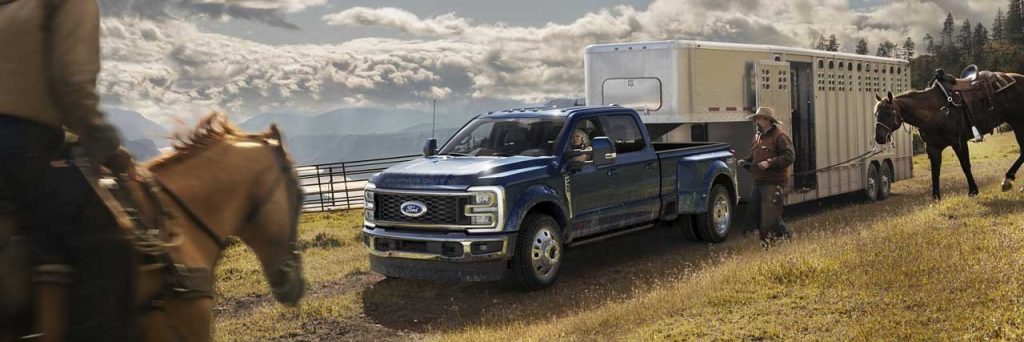
Ford trucks have helped Farm and Agricultural operations in Oklahoma meet their goals for decades. From the flagship Ford F-150 to the Ford Super Duty Line, our inventory is full of Ford trucks that can help you manage your operations successfully. From class-leading towing capacities to substantial payload capacities, these Ford trucks are built to get the job done under pressure. Visit Bob Moore Ford Pro to speak with our commercial vehicle experts to find the perfect fit for you and your business.
The Ford trucks available at Bob Moore Ford have built a reputation in the farming industry for their impressive towing and hauling capabilities. The Ford F-Series can get the job done whether you’re hauling hay, feed, equipment, or supplies on your farm. Here’s how the Ford F-Series Pick-ups line-up in towing and hauling capacities:
Ford F-150
Ford F-250
Ford F-350
Ford F-450
Ford trucks are built to withstand the daily rigors of farm and agricultural work. From the frigid winters to hot summers, Ford trucks are designed to uphold their integrity through the wear and tear of farm life. Visit Bob Moore Ford to explore our extensive selection of trucks that can help your farm and cattle operation succeed.
Oklahoma serves as a beacon of the agricultural industry throughout the United States. Between livestock and crop production, Oklahoma has outstanding rates of interstate and international exports, and holds the top spot in production for several different types of foods. Agriculture is not only a large part of Oklahoma’s current state, but also serves as a major part of the state’s history brought to fruition by early immigrants to the region. Oklahoma even served as ground zero for the great dust bowl during the great depression, and has since cultivated their region to be more successful than ever before. Oklahoma’s serves as a key player in the worldwide cattle and farm industry.
The farming industry in Oklahoma began in the very early days of United States settlement history. Farms were run by immigrants from Germany, Russia, England, Scotland, Ireland, and their continuing descendants. Carrying many traditions of eastern and western European agriculture, farmers in the region developed Oklahoma into the agricultural powerhouse that it is today. In the 1930s, America was recovering from World War One and many farmers struggled to keep up with the necessary wheat production in order to support the war effort. Many crops had been over-farmed, thus hurting the overall soil quality which eventually led to the beginning of the Dust Bowl. Today conservation efforts have led to rich soil, plentiful harvests, and consistent crop growth throughout the entire state with many successful man made lakes and irrigation systems.
Oklahoma also possesses a decorated and interesting history of the cattle industry, which contributes a large part of its exports and overall GDP. In the late 1800s Oklahoma became a major thoroughfare for giant cattle drives coming up North from Texas, and served as part of two major routes of the Old West. Over time, cattle raising began to be a permanent staple within Oklahoma, and as this became a more common economic product, farmers moved towards better breeding with better care and handling. In 1910, Edward Morris opened the Oklahoma City stockyards which are still thriving today; the facility is served by excellent highway access, local ranches, livestock farms, and nearby grain producing areas.
Oklahoma serves the nation, in fact the world, and its many agricultural exports. The state ranks as number one exports of winter wheat, which has been a primary staple of Oklahoma for decades. They also play host to crops such as corn for grain, peanuts, and pecans. Due to its rolling landscape, Oklahoma is also a big producer of hay from its native grass and commonly found alfalfa.
Oklahoma has been in the top five states for many years in cattle and calf production, and cattle is considered one of the top income sources for the entire state. Every year, Oklahoma generates around $6.5 billion in agricultural production of cattle, this alone represents about 3.2% of the state’s total gross domestic product. The industry contributes directly to local and state economies which are reinvested into Oklahoma communities. Oklahoma alone produces over 2% of all American dairy products and over 5%of all American beef.
Copyright © 2022 Bob Moore. All rights reserved.